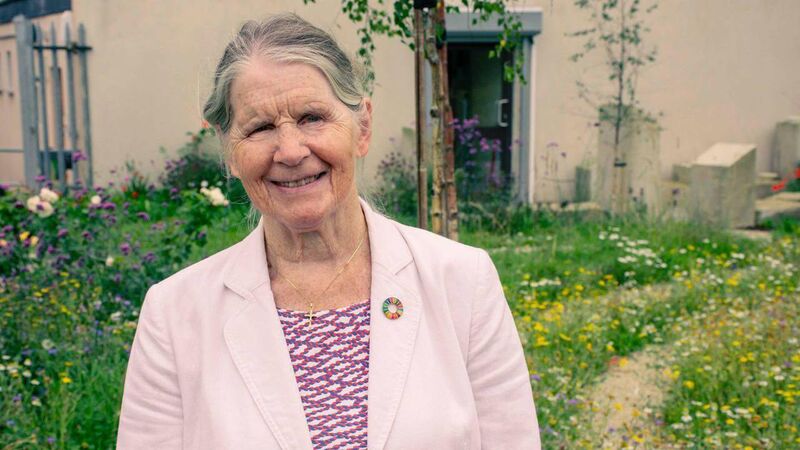Clodagh Finn: Imagine a Church in which Sr Stan had been a bishop

Sr Stan set up numerous organisations, transforming the lives of thousands of people.
There have been multiple tributes to the towering legacy left behind by Sr Stanislaus Kennedy, a social justice campaigner who “started things with nothing”, as she put it herself, but went on to achieve so much.
She cut a swathe through the red tape of civil society to set up numerous organisations, transforming the lives of thousands. There was much opposition. Former taoiseach Charlie Haughey, for instance, once described her as the most intransigent woman he had ever met.
She wore the remark as a badge of honour and used it to sharpen her resolve to help those most in need. She had considerable success. But imagine the further impact she might have had if this woman of deep faith and even deeper determination had been allowed to advance in the hierarchy of her own Church.
In lay society, she was a leader, a founder, a chairwoman, a co-ordinator, the head of several institutions. In religious life, however, she was simply Sr Stan, although her pioneering work and her commitment to the poor was certainly on a par with her mentor, the bishop of Ossory, Peter Birch.
Imagine if the Church had appointed her a bishop.
HISTORY HUB
If you are interested in this article then no doubt you will enjoy exploring the various history collections and content in our history hub. Check it out HERE and happy reading
Her own early work in the Church was shaped by the bishop of Ossory. In the mid-1960s, she was sent to Kilkenny to help him set up a pioneering project, Kilkenny Social Services. She believed, as he did, that the Catholic Church needed to do more to help the poor.
Except she did not have the right to say so. When she wrote a paper pointing out that the Church wasn’t using its resources to help the poor, “all hell broke loose”, as she recalled later. “People were furious, bishops were furious, I got a letter from Rome. In the end of it, I was silenced. But then I rose up again and started speaking out again.”
She did that again and again, speaking out against mandatory celibacy for priests and nuns, speaking up for a yes vote in the 2015 referendum on same-sex marriage and advocating for equality for women within the Catholic Church.
If her calls for equality in the structure of the Church made little more than an uncomfortable ripple, the opposite was true in lay society. Her many successes have been outlined in detail in recent days.
It is impossible to do justice to all of that here but let us recall them in broad brush strokes. She set up Focus Point (now Focus Ireland) to help the homeless in 1985. In 1998, she founded the Sanctuary, a meditation centre in Dublin city. The Immigrant Council of Ireland and the Young Social Innovators followed in 2001. There were myriad projects and thousands of articles, lectures and books.
You have the definition of intransigence right there.
Perhaps it is naïve to expect any change because we have seen, with depressing clarity, how unwilling the Church has been to pay redress, or even fully acknowledge, the unspeakable wrongs perpetrated in so many of its institutions and schools.
Sr Stan herself was not untouched by controversy.
The Ryan Report claimed she had been told of the abuse of children at St Joseph’s Industrial School in Kilkenny, a finding she firmly rejected. She found it deeply hurtful but she did contrast her own hurt with the greater hurt the children went through, “which was terrible”.
She also spoke about the unfair depiction of the Sisters of Charity during the controversy over the transfer of St Vincent’s hospital to the National Maternity Hospital and said, in any other context, the depiction of her order as “a power-grabbing congregation” would be considered “elder abuse”.
Speaking of context, it is always helpful to remember the beginnings of things. In this case, the radical philosophy that informed Sr Stan’s congregation when it was founded in 1815 by Cork woman Mary Aikenhead.
At the time there were about 100 women in religious orders in Ireland, all of them safely cloistered behind convent walls.
For the first time, Mary Aikenhead and her sisters ventured out into the community to help the sick and the poor. They ran schools and visited prisons to spend time, in dank cells, with those facing long sentences and, in some cases, execution.
This column has cited before the remarkable entry in the diary of Mother Catherine (Alicia Walshe) which describes how she and Mary Aikenhead made daily visits to Kilmainham Jail to visit Biddy Butterly and Biddy Ennis, two young women awaiting execution after they were convicted of murdering their mistress, Miss Thompson.
Hours before the baying crowds gathered to watch the execution in May 1821, the two women visited again “to comfort and assist in preparing for death”. That remarkable insight, courtesy of social historian Ciarán McCabe in an article in Archivium Hibernicum, reveals a very hands-on pastoral Church willing to care for even the most wayward of its flock.
It’s easy to forget too, given the recent controversy, that Mary Aikenhead established St Vincent’s Hospital in Dublin in 1834 so that the poor – “the chosen children of God”, in her view — would receive the same medical care as the rich, but without charge.
You have to wonder if the women who worked so arduously in the service of the poor had been more prominent in the hierarchy of the Catholic Church, whether we might have avoided the unconscionable hurt the institution inflicted in later years.
It’s impossible to say, but I can’t sign off without noting that Sr Stan died at St Francis Hospice in Blanchardstown.
That brought film-maker Alan Gilsenan’s powerful documentary series to mind.

In 2007, Gilsenan wrote this about his mother’s reaction to her terminal diagnosis. “Sucking deep on a Silk Cut (Extra Mild, of course), in a strangely matter-of-fact manner, my mother said, “I'll have to go to Pearl...”. She was newly diagnosed terminally ill and Pearl was Pearl Phelan, her girlhood friend and cousin from Tipperary. But Pearl was also Sr Ignatius of Our Lady's Hospice, Harold's Cross.”
She was also a Religious Sister of Charity and a pioneer in the development of end-of-life and palliative care in Ireland.
In 1987, her work was acknowledged with a Rehab People of the Year award which she received with fellow Religious Sister of Charity, Sister Francis Rose O’Flynn. The judges described their work at Our Lady’s Hospice as “a modern-day miracle”.
When Pearl died in 2010, her nephew John Blake Dillon recalled a woman who had four families — her physical family, her religious community, the hospice and the families of those she helped to negotiate a path through terminal illness and bereavement.
He also said that her leadership style and skill were best summed up by Chinese philosopher, Lao Tzu, who said: “As for the best leaders — the people do not notice their existence.”
That might well be true but it is beyond time that the work of these remarkable women, who moved heaven on earth to improve people’s lives, was at least acknowledged in the hierarchy of the Church they did so much to serve.















